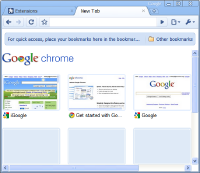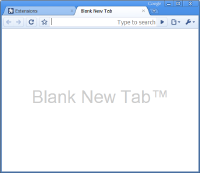Except as otherwise noted, the content of this page is licensed under the Creative Commons Attribution 3.0 License, and code samples are licensed under the BSD License.
©2011 Google
Override pages are a way to substitute an HTML file from your extension for a page that Google Chrome normally provides. In addition to HTML, an override page usually has CSS and JavaScript code.
An extension can replace any one of the following pages:
Note: A single extension can override only one page. For example, an extension can't override both the Bookmark Manager and History pages.
Incognito windows are treated specially. New Tab pages cannot be overridden in incognito windows. Other override pages work in incognito windows as long as the incognito manifest property is set to "spanning" (which is the default value for extensions but not for packaged apps). See Saving data and incognito mode in the Overview for more details on how you should treat incognito windows.
The following screenshots show the default New Tab page next to a custom New Tab page.
| The default New Tab page | An alternative New Tab page |

|

|
Register an override page in the extension manifest like this:
{
"name": "My extension",
...
"chrome_url_overrides" : {
"pageToOverride": "myPage.html"
},
...
}
For pageToOverride, substitute one of the following:
bookmarks
history
newtab
For an effective override page, follow these guidelines:
Make your page quick and small.
Users expect built-in browser pages to open instantly.
Avoid doing things that might take a long time.
For example, avoid synchronous fetches of network or database resources.
Include a title in your page.
Otherwise people might see the URL of the page,
which could be confusing.
Here's an example of specifying the title:
<title>New Tab</title>
Don't rely on the page having the keyboard focus.
The address bar always gets the focus first
when the user creates a new tab.
Don't try to emulate the default New Tab page.
The APIs necessary to create
a slightly modified version of the default New Tab page —
with top pages,
recently closed pages,
tips,
a theme background image,
and so on —
don't exist yet.
Until they do,
you're better off trying to make something completely different.
See the override samples.